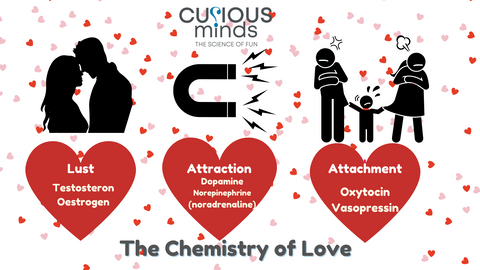What Is Love? It's a question that's been asked many times and as Valentine's day is approaching, we thought we'd take a look at romantic hearts & roses love and the science behind romantic attraction.
Scientists have broken romantic love down into three distinct phases: lust, attraction & attachment. And far from being in control of your emotions, we’re here to tell you, the success of your romantic endeavours is down to the complicated interplay between a batch of chemicals, known as hormones swishing around in your body. Doesn’t sound so romantic now does it?

Lust is the drive for sexual gratification, the ultimate objective is reproduction of ourselves, in the form of babies, to perpetuate our species. But having a baby is likely not to be at the front of our minds on that very first date, nope, our minds are elsewhere! Our eyes will be locked on the focus of our attention, and that’s interesting as the eyes are extrusions of our brain and the only part of our brain that sits outside our skull. The eyes play a big role in deciding if we’re sexually attracted to the person in front of us and send messages back to the brain to say yes he’s a hunk, we’re interested or nope not this time, he’s not for us.
The old adage of his heart ruled his head, turns out to be entirely wrong because in fact a specific region of his head and our heads, known as the hypothalamus, is in control of the urge for sexual gratification. The hypothalamus is responsible for stimulating the production of the sex hormones testosterone in the testes and oestrogen in the ovaries. We tend to categorise testosterone as a male hormone, but it is also present in the female body, in lower levels and plays an important role in libido for women too. Menopausal women who experience declining synthesis of the sex hormones often report a corresponding decline in their sex drive.
Oestrogen is also important for driving our lustful desires, and interestingly, there are reports of women being more sexually receptive around the time of ovulation when oestrogen levels are higher, which makes marvellous reproductive sense as the chances of pregnancy are increased.
Once we’re comfortably in the lustful stage of our romantic encounter, we then begin to move into the attraction phase and other hormones are also stimulated by the hypothalamus. In particular dopamine and noradrenaline.
Dopamine is often described as the reward hormone, it is released in high levels when we’re pleased with something we’ve done or something someone says to us, ie when something makes us feel good, such as spending time with someone we’re attracted to, or having sex.
Norepinephrine, also known as noradrenaline is the fight or flight hormone which is released when we need to run from danger or stand and fight to protect our children. It’s swiftly released into our bodies when we’re stressed and interestingly is also released in response to our attraction to someone. These two hormones, noradrenaline and dopamine, are responsible for giving us the giddy, euphoric feeling and can even suppress our appetite; she’s so love-sick she can’t eat.
Once your relationship with the new love of your life is established your relationship moves into the attachment phase, you’re now a couple and beginning to look to a future together. As with the previous phases of lust and attraction, the attachment phase is also controlled by another hormone called oxytocin.
Oxytocin, synthesised in the pituitary gland, is affectionately known as the cuddle hormone. It’s important for long term romantic intimacy, that cuddle whilst you’re doing the dishes together, or cuddled up on the sofa. But it’s also especially important during bonding between parents and their new-born babies and is extremely important for breastfeeding mothers, known as the oxytocin reflex, the release of oxytocin results in milk let-down.
And so the next generation is borne and the hormones got their way!
We hope you’ve found our brief introduction to the science of love interesting, and it hasn’t taken the romance out of St Valentine’s Day for you. Whatever you’re planning on the 14th we hope s/he appreciates your efforts.
And if you're looking for an unusual gift check out our Valentine's range here
Have a wonderfully romantic day!





